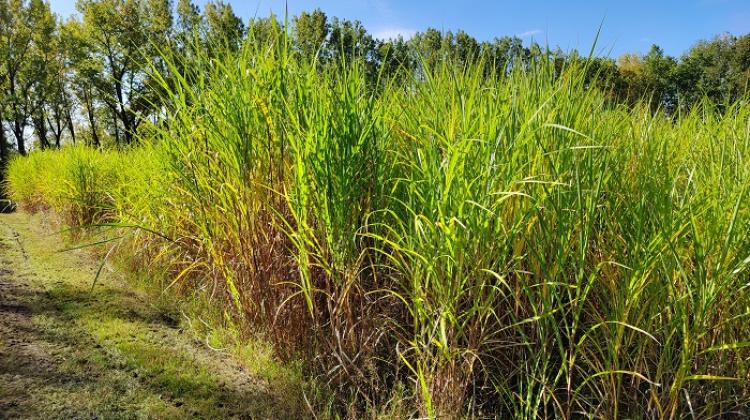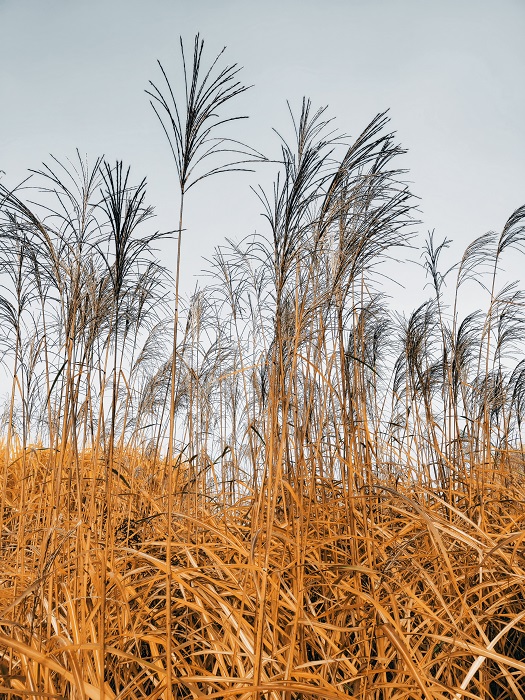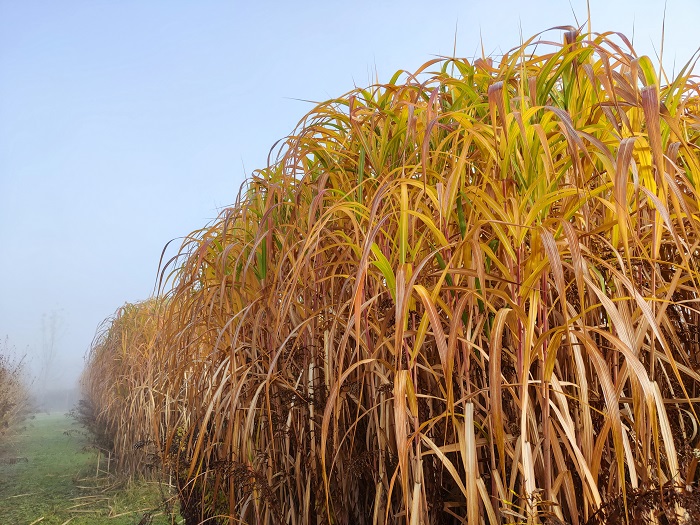Miscanthus biomass from contaminated soil crops useful in production of biofuels and biomaterials
 Giant miscanthus. Credit: J. Krzyżak
Giant miscanthus. Credit: J. Krzyżak
Fuel and cellulose can be obtained from the giant miscanthus biomass; such cellulose can be used in building materials. Polish, German and British scientists examined the impact of growing this plant on soil quality, biomass production volume and the uptake of pollutants in soils contaminated with heavy metals.
Giant miscanthus (Miscanthus giganteus) is a perennial rhizomatous grass from East Asia. It is a beautiful hybrid of Miscanthus sinensis and Miscanthus sacchariflorus. Its height can reach 2 to 4 meters. Miscanthus has long, deep green leaves that form impressive, dense clumps, and grows very quickly. In the centre of each leaf blade there is a characteristic white stripe along the main vein. In autumn, the leaves turn to a warm straw colour.
Miscanthus is an energy crop grown to obtain energy from biomass accumulated during the photosynthesis process. Energy plants can be used to produce electricity, heat or biofuels. Many different species of energy crops are cultivated in Poland. Trees and shrubs include, for example, energy willow, hybrid poplar, multiflora rose, Virginia mallow, and grasses: giant miscanthus, reed canary grass, big bluestem, and switchgrass.

Scientists from the Institute for Ecology of Industrial Areas (IETU) in Katowice, the Research and Innovation Centre Pro-Akademia in Konstantynów Łódzki, the University of Hohenheim in Germany and the Aberystwyth University in the UK decided to investigate the impact of the cultivation of miscanthus and its seed hybrids on soil quality, biomass production volume and uptake of pollutants on soils contaminated with heavy metals. Biomass was converted for energy purposes, and energy recovery in the combustion process, biogas production and biomass gasification was examined.
In the Polish part of the project, research was conducted at the IETU testing area in Bytom. 'We conducted research on agricultural soil contaminated with cadmium, zinc and lead as a result of past operations of zinc and lead smelters in the area; the soil was contaminated due to the deposition of heavy metals emitted by steelworks into the air,’ says Dr. Jacek Krzyżak from IETU. The level of contamination exceeded the maximum permissible cadmium, lead and zinc contents for agricultural soils by a few to a dozen times.
The scientists' approach focused on selecting plants that would not absorb excessive amounts of heavy metals and would be able to grow effectively in a contaminated environment.
'Miscanthus turned out to be very good, it produced a dense system of rhizomes and roots in the soil, retained pollutants in the root zone and did not absorb them into the above-ground part,’ says Dr. Krzyżak.

According to the scientist, miscanthus is also able 'to sequester carbon dioxide in the form of organic carbon in rhizomes and roots, positively affecting the quality of the soil, improving the content of organic matter'. 'In general, the impact of growing this species on soil quality was very positive,' Krzyżak says.
The researcher emphasises that miscanthus biomass could be an 'economically viable' crop with a range of end uses, for example as a solid fuel, in building materials such as pressed particle board, and as a source of cellulose. However, he admits that the establishment of M. giganteus in agriculture, especially in the temperate climate of Europe and North America, 'may be a challenge due to the relatively high costs of establishment, small genetic base and low resistance to negative temperatures during the first winter after establishing the plantation.’
Miscanthus is harvested every year in late winter or spring of the following year. During this time, the content of minerals is reduced as a result of their remobilisation (transfer) to the rhizomes. 'A low content of minerals at the time of harvest is desirable in biomass intended for thermal conversion (combustion), because it minimises the negative impact on combustion efficiency and reduces emissions,’ Krzyżak says.
The economic life of the crop is estimated to be at least 10-15 years of harvest.
'Due to the C4 photosynthetic pathway and perennial rhizomes, miscanthus has an efficiency of 15-20 tons of dry matter per hectare per year,’ Krzyżak says.

The research was conducted as part of the projects MISCOMAR (Miscanthus biomass options for contaminated and marginal land: quality, quantity and soil interactions, implemented in 2016-2019) and MISCOMAR+ (Miscanthus for marginal and contaminated lands PLUS, implemented in 2020-2024, recently completed). Both projects were financed by the Era-Net FACCE SURPLUS initiative through the Polish National Centre for Research and Development.
IETU scientists have been dealing with the management of soils contaminated with heavy metals since the very beginning of the Institute's existence. In 2007, the first energy plants were planted - giant miscanthus, and since 2010, a number of other species of energy plants have been tested.
In the years 2014-2019, IETU implemented a project financed by FP7 - Phyto2Energy, which examined the possibility of producing energy plant biomass on soils contaminated with heavy metals. The research was conducted in Poland - on agricultural soil contaminated with cadmium, lead and zinc, and on a reclaimed municipal waste landfill in Leipzig, Germany, also contaminated with these elements. In this project, the studied plant species were giant miscanthus, Virginia mallow, prairie cordgrass and switchgrass. As part of an international consortium, research was also carried out on energy recovery from the produced biomass in the gasification process. (PAP)
PAP - Science in Poland, Anna Mikołajczyk-Kłębek
amk/ bar/ kap/
tr. RL
Przed dodaniem komentarza prosimy o zapoznanie z Regulaminem forum serwisu Nauka w Polsce.


















